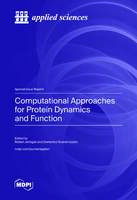Dublin Core
Title
Computational Approaches for Protein Dynamics and Function
Subject
Research and information: general
Biology, life sciences
Description
Proteins are fascinating structures that operate at the nanoscale in a complex environment and are involved in an astonishingly wide variety of functions, from ion transport to enzymatic catalysis, metabolism, neurotransmission, and many more functions. Understanding these peculiar functionalities at the single-protein level requires advanced experimental and computational techniques. In the era of high-performance computing, computational methods are particularly well suited to investigating the structure and dynamics of proteins and unravelling how they enable biological functions. Molecular Dynamics (MD), Normal Mode Analysis (NMA), and Elastic Network Models (ENMs) are just a few examples of the computational methodologies that we can use to elucidate protein conformational dynamics, allostery, the impact of mutations, and many other fascinating subjects. This Special Issue comprises eight peer-reviewed papers demonstrating how various computational approaches can be employed to address the ultimate and most crucial question: how do proteins work?
Creator
Jernigan, Robert (editor)
Scaramozzino, Domenico (editor)
Source
https://mdpi.com/books/pdfview/book/10151
Publisher
MDPI - Multidisciplinary Digital Publishing Institute
Date
2024
Contributor
Andri Yanti
Rights
https://creativecommons.org/licenses/by/4.0/
Format
Pdf
Language
English
Type
Textbooks
Identifier
DOI
10.3390/books978-3-7258-2556-1
10.3390/books978-3-7258-2556-1

